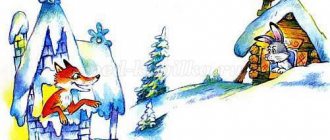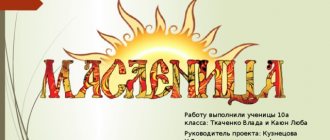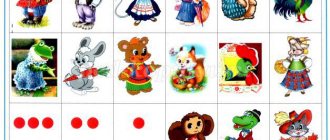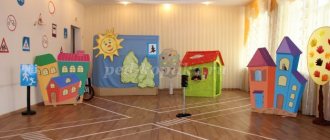Retelling of the fairy tale “The Fox and the Jug” (older age)
Topic: Retelling the fairy tale “The Fox and the Jug”
(older age)
Directions of children’s development:
speech, social - communicative, artistic - aesthetic, cognitive.
Types of children's activities:
speech, gaming, communicative, productive, cognitive.
Target:
continue to teach children to emotionally perceive the figurative content of a fairy tale, comprehend the characters and actions of the characters, and promote the development of coherent speech.
Tasks:
- Continue learning to retell r.n.s. "The Fox and the Jug"
consistently, expressively, close to the text, using speech patterns from the text, answer questions, dramatize, select your own decorations and arrange them. Develop skills of cooperation and mutual assistance. Activate the dictionary. Create conditions for practical mastery of spoken language. Ensure the development of thought processes in children. Stimulate the desire to explain what is happening and reason.
- Develop attention, memory, thinking, coherent speech (dialogue,
monologue), intonation expressiveness of speech, play activities, communication and creative abilities.
- To cultivate interest in Russian folk art, to
fine arts, moral qualities (don’t brag, come to the rescue in a difficult situation). Equipment:
multimedia installation, chest, illustrations r.n.s.
“The Fox and the Jug”, material for children’s arts and crafts, waste and natural materials, laptop, camera. Vocabulary work:
- activation – selection of affectionate adjectives for the noun “chest”,
- vocabulary enrichment – “stuck in”, “full”, “darling”, “reap”
Contents of organized activities for children:
Methodological techniques:
1.Game situation – Goal:
to ensure motivation for children’s upcoming activities and acceptance of the goal.
(Skype signal) Teacher:
“What could this be?”
Children: “
bell, signal, they’re calling us.”
Teacher: “
What do you propose to do?”
Children:
“Turn on the connection, we will find out who is calling us” (the Storyteller appears on the screen)
Storyteller: “
Hello guys!
I am a Storyteller. I was on my way to tell the kids a fairy tale, but the trouble is, I lost the chest with the fairy tale on the road, the kids are waiting, but the fairy tale cannot be told without the fairytale chest. I am very far from you. Guys, can you help me find the chest and let the kids meet the fairy tale?” Educator:
“Children, can we help the Storyteller?
How?" (children's assumptions to find the chest, children are looking for the chest) Teacher:
“Bring the chest here.
Do you think this is the chest? How can we find out? (children’s suggestions to open it, see what’s in it, the chest does not open) Educator:
“What should we do to make it open?”
2. Didactic exercise “
Magic chest”
Purpose:
to practice selecting affectionate adjectives for the noun “chest”
Children
: nice, affectionate, wonderful, good, amazing, gentle, kind, beloved, etc.
(chest opens) Educator:
“What did you see?
Have we already met them somewhere?” 3. Didactic exercise
“Learn a fairy tale”
Goal
: updating children’s past experience, children recognizing a familiar fairy tale from illustrations.
Children:
“Illustrations from the R.N.S.
“The Fox and the Jug” Teacher:
“Is this really the fairy tale “The Fox and the Jug?”
(children prove by the characters of the fairy tale) Educator:
“It turns out that we found the chest, the fairy tale too, we recognized it as a fairy tale. How can we convey it to the Storyteller? After all, she is far from us? (children’s proposals - convey by phone, on TV, via Skype, transmit a book, via the Internet - this is very fast and modern; prepare costumes, go as artists and show a fairy tale, photograph, voice over and send by e-mail)
Educator:
“Guys, let’s remember the fairy tale, splitting the pictures in sequence, pay attention to the screen (image of the fairy tale on the slides)
Educator:
“It’s time to get down to business” (children lay out the pictures, leaning on the screen)
4. Retelling the fairy tale when drawing up the layout Purpose:
to help comprehend the idea, character and the actions of the heroes.
Educator:
Questions:
- What is the name of the fairy tale?
- What was the woman doing in the field? (meaning of the word "sting")
- What did the fox do? (meaning of the word “stuck in”)
- How can you characterize a fox? (greedy)
- How did the fairy tale end?
5. Physical exercise
Goal:
change the static pose to an active one.
Children:
“Show:”
- How does a fox walk?
- How does he shake his head?
- How does a fox run?
6. Drawing up a layout for the fairy tale “The Fox and the Jug”
Goal:
convey the emotional characters and behavior of the characters yourself, put on costumes, prepare the stage (scenery)
Work with waste material (drawing up a layout, discussing which figures will be chosen for the fox, woman, river, jug )
7. Summary:
(video recording
- The storyteller
thanks that she quickly received the fairy tale on the Internet and the kids were able to hear and see it, and the kids are also waiting for artists who can show a performance of the fairy tale)
Purpose:
assessment of the children’s activities.
Educator:
- “What fairy tale did we meet today?”
- “What new words did you use in your speech?”
- “Is it good to be greedy?”
- “Who will you share what you did with?”
- “What did you especially like today?”
Guys, I want to thank you, you are all great, you did a good job, you helped the Storyteller, thank you very much, accept a gift from me, you will play in your group.
Lesson objectives
Educational
- to develop in children the ability to listen carefully to an adult’s story, to follow the rules of a group game; develop learning skills (answer an adult’s questions, listen to the answers of other children, do not interrupt the speaker).
Educational
— improve gross motor skills; consolidate children's knowledge on the topic “Where did the bread come from”; consolidate the general concept of “animals”; introduce children to new words: “rye”, “ears”, “grain”, “sheaf”, “sickle”, “jug”, “reap”; introduce the prepositions “for”, “before” into the children’s active vocabulary; adverbs “in front”, “behind”, “left”, “right”.
Developmental
— train children’s auditory and visual attention, the ability to solve riddles, and the ability to comprehend the events of a fairy tale.
Equipment:
- figures of fairy tale characters - a woman, a fox (see insert, Fig. 5, 6);
subject pictures - jug, sickle, sheaf (see insert, Fig. 7-9);
scenery: field, river (see insert);
demonstration drawing “Where is the jug?” (Fig. 11, p. 36).



